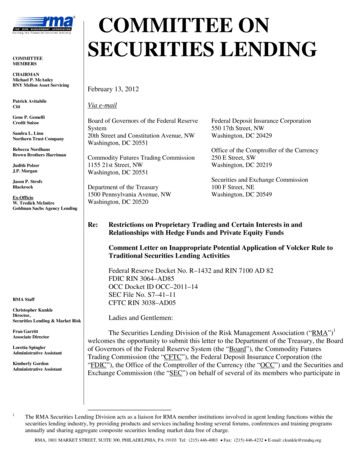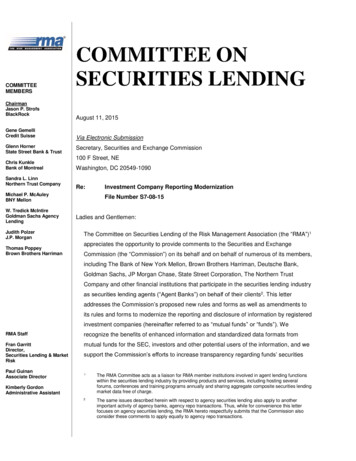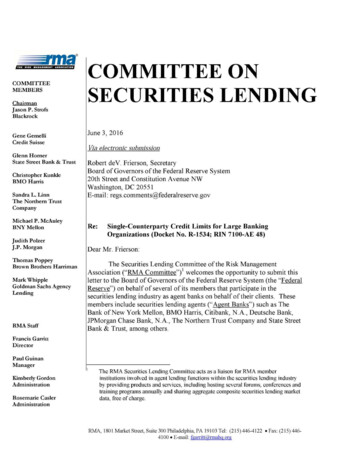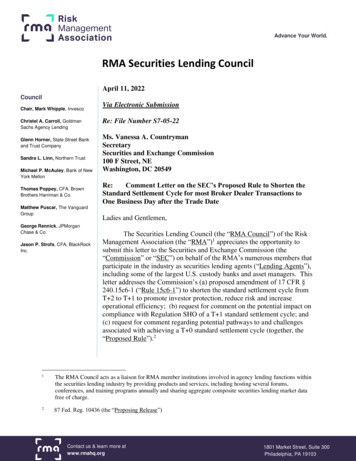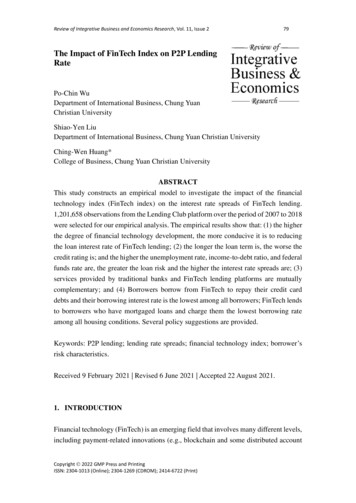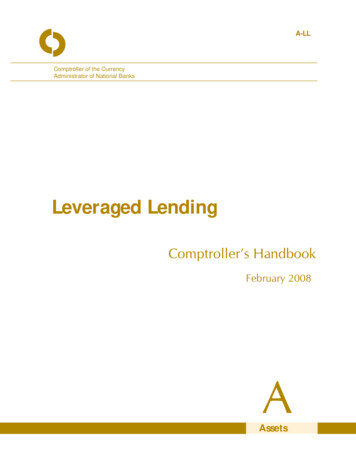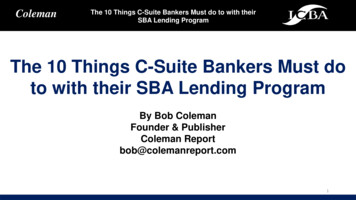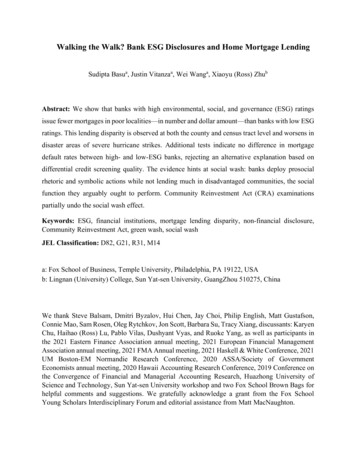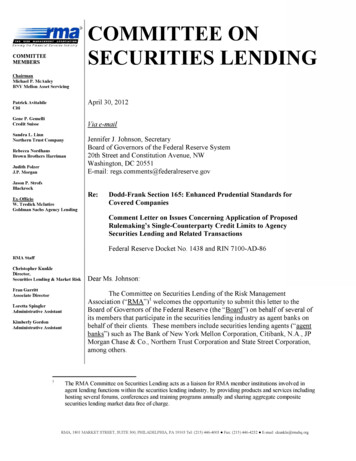
Transcription
SCOMMITTEE ONSECURITIES LENDINGChairmanMichael P. McAuleyBNY Mellon Asset ServicingApril 30, 2C12Patrick AvitabileCitiGene P. GemelliCredit SuisseVia e-mailSandra L. LinnNorthern Trust CompanyRebecca NordhausBrown Brothers HarrimanJudith PolzerJ.P. MorganJennifer J. Johnson, SecretaryBoard of Governors of the Federal Reserve System20th Street and Constitution Avenue, NWWashington, DC 20551E-mail: regs.comments@federalreserve.govJason P. StrofsBlackrockEx-OfficioW. Tredick McIntireGoldman Sachs Agency LendingRe:Dodd-Frank Section 165: Enhanced Prudential Standards forCovered CompaniesComment Letter on Issues Concerning Application of ProposedRulemaking's Single-Counterparty Credit Limits to AgencySecurities Lending and Related TransactionsFederal Reserve Docket No. 1438 and RIN 7100-AD-86RMA StaffChristopher KunkleDirector,Securities Lending & Market RiskFran GarrittAssociate DirectorLoretta SpinglerAdministrative AssistantKimberly GordonAdministrative AssistantDear Ms. Johnson:The Committee on Securities Lending of the Risk ManagementAssociation ("RMA")1 welcomes the opportunity to submit this letter to theBoard of Governors of the Federal Reserve (the "Board") on behalf of several ofits members that participate in the securities lending industry as agent banks onbehalf of their clients. These members include securities lending agents ("agentbanks") such as The Bank of New York Mellon Corporation, Citibank, N.A., JPMorgan Chase & Co., Northern Trust Corporation and State Street Corporation,among others.1The RMA Committee on Securities Lending acts as a liaison for RMA member institutions involved inagent lending functions within the securities lending industry, by providing products and services includinghosting several forums, conferences and training programs annually and sharing aggregate compositesecurities lending market data free of charge.RMA, 1801 MARKET STREET, SUITE 300, PHILADELPHIA, PA 19103 Tel: (215) 446-4003 Fax: (215) 446-4232 E-mail: ckunkle@rmahq.org
April 30, 2012Page 2This letter specifically addresses the Board's proposed rules implementing the singlecounterparty credit limits mandated by Section 165(e) of the Dodd-Frank Act,2 which are asubpart of the proposed rulemaking implementing the enhanced prudential standards set forthin Sections 165 and 166 of the Dodd-Frank Act (the "Proposed Rules"). 3 The Proposed Rulesimpact agent banks as a result of the securities replacement guarantee, or borrower defaultindemnification, that is provided by agent banks to their lending clients as part of their agencysecurities lending programs.The RMA task force principally is concerned that the Proposed Rules significantlyoverstate actual exposures relating to the securities replacement guarantee. Under anapplication of the Proposed Rules as currently drafted, such an overstatement of exposurewould cause agent banks to curtail significantly transactions with large counterparties andcollateral issuers. Such restrictions thus could severely impair long-established bank securitieslending agent activities as well as other relationship-driven activities of many of RMA'smembers, while also impacting market liquidity by reducing the volume of securities availablefor loan.This letter discusses why it would be inappropriate for Section 165(e)'s concentrationlimits to inhibit the operation of banks' traditional agent lending activities to such a significantextent and details some approaches to address these concerns.The analysis set forth in this letter supports the following conclusions: The securities replacement guarantee protection provided by agent banks as a standardmarket practice is a common feature in agency securities lending that is highly valuedby institutional lending clients. As a policy matter, indemnified agency securities lending does not pose the systemiccounterparty risks Section 165(e) was meant to address and is already a well-regulated,well-established bank-level activity at agent banks. As applied to agency securities lending activities, the Proposed Rules as currentlydrafted give rise to a number of concerns, including the following:oAs to securities replacement guarantees (also called borrower defaultindemnification) provided in connection with agency securities lending services,the sections of the Proposed Rules implementing the single-counterparty creditlimits grossly overstate exposure risk associated with this market practice, by,among other things, not taking into account correlations between securities lent andcollateral received. This, in turn, may lead to the following adverse outcomes:2Dodd-Frank Wall Street Reform and Consumer Protection Act, Public Law 111-203, 124 Stat. 1376 (2010)(the "Dodd-Frank Act").3Enhanced Prudential Standards and Early Remediation Requirements for Covered Companies, 77 Fed. Reg.594 (Jan. 5, 2012). The Proposed Rules implementing Single-Counterparty Credit Limits are set forth inSubpart D.RMA, 1801 MARKET STREET, SUITE 300, PHILADELPHIA, PA 19103 Tel: (215) 446-4003 Fax: (215) 446-4232 E-mail: ckunkle@rmahq.org
April 30, 2012Page 3 It could limit U.S. agent banks' ability to lend to high-quality borrowers undertheir indemnified agency lending programs; If agent banks are discouraged from offering securities replacement guaranteesto their lending clients, many lenders (in some cases, to comply with law orpolicy) may (i) withdraw supply from the market, (ii) move their business toforeign banks or other financial entities not subject to the exposure limits, or(ii) in the case of some larger lenders, potentially run their own lendingprograms without the risk control systems and expertise of agent banks; and Reduced lending supply caused by a withdrawal of securities lenders from themarket could both reduce liquidity in the broader market and reduce returns forthose government plans and other clients who exited from lending.oAs to collateral, under the Proposed Rules' method of calculating net exposure byshifting exposure to the collateral issuer, the Proposed Rules could significantlyimpact agent banks' abilities (i) to facilitate securities lending transactions in whichthe borrower posts high-quality foreign sovereign or other highly liquid non-cashcollateral and (ii) to compete in non-U.S. markets where non-cash collateral ispredominant.oIn all cases, the method of calculation of counterparty exposure prescribed by theProposed Rules is vastly different from the methods used by agent banks to complywith current regulatory requirements and presents acute implementation issues.Such inappropriate outcomes could be remedied in the following ways, beginning withthose that most closely align with appropriate regulatory treatment:1. Provide agent banks with the option to use the simple Value at Risk ("VaR")modeling methods that a number of agent banks currently use to comply withcapital rules to calculate net credit exposure, consistent with Basel IImethodologies approved by regulatory agencies for use by such agent banks underthe Basel I framework, instead of the static, uncorrelated haircuts set forth in Table2 of the Proposed Rules;2. If the Board is concerned with standardizing banks' modeling methodologies toensure control over their application for purposes of the single-counterparty creditlimits, provide agent banks with the option to use a simple VaR model with astandardized set of assumptions and other inputs specified by the Board; or3. Use more "reasoned" haircuts to calculate net credit exposure. In addition to some of the revisions to the calculation of net credit exposure listedabove, we ask that the Board address further implementation issues under the ProposedRules with solutions including, among others:oAn exemption for certain high-grade foreign sovereign debt, which is often postedas non-cash collateral by borrowers,RMA, 1801 MARKET STREET, SUITE 300, PHILADELPHIA, PA 19103 Tel: (215) 446-4003 Fax: (215) 446-4232 E-mail: ckunkle@rmahq.org
April 30, 2012Page 4oAppropriate treatment of invested cash collateral and cash collateral pools,oA more appropriate definition of "subsidiary," andoA more extended applicability timeline and grace period for non-compliance.RMA, 1801 MARKET STREET, SUITE 300, PHILADELPHIA, PA 19103 Tel: (215) 446-4003 Fax: (215) 446-4232 E-mail: ckunkle@rmahq.org
April 30, 2012Page 5SUMMARY TABLE OF CONTENTSI.A.B.II.Overview of the agency securities lending market and the securitiesreplacement guaranteeMarket overviewThe securities replacement guarantee, provided as a matter of market practicein agency securities lending transactions, results in minimal overnightcounterparty credit exposure at agent banksPurposes of the single-counterparty exposure limits and application toagency securities lending and borrowing transactionsA. PurposesB. Agency securities lending transactions do not pose the systemic risks andregulatory concerns that Section 165(e) was intended to addressC. Issues with inappropriate application of current Proposed Rules to agencysecurities lending transactions1. Gross overstatement of risk associated with securities replacement guarantees2. Exposure limits may impact ability to accept certain collateral3. Difficulty of implementation4. Market impacts5. Complex issues involved in setting single-counterparty credit limits requirecareful considerationIII.A.Proposed ResolutionsThe final rule should allow banks to use their approved VaR methodology tocalculate exposure associated with securities financing transactionsB. The VaR model may be adjusted by the Board to ensure uniformity inapplicationC. At a minimum, the Proposed Rules should be amended to use more "reasoned"haircuts in the case of securities financing transactionsD. Certain additional implementation issues should be addressed1. Treatment of foreign sovereign debt2. Netting of exposures to same issuer3. Reinvested cash collateral4. Cash collateral pools5. Definition of "counterparty," "subsidiary" and "control" in general6. Attribution Rule7. Timeline; Grace PeriodIV.ConclusionRMA, 1801 MARKET STREET, SUITE 300, PHILADELPHIA, PA 19103 Tel: (215) 446-4003 Fax: (215) 446-4232 E-mail: 23242526272729
April 30, 2012Page 6I.Overview of the agency securities lending market and the securities replacementguarantee.A.Market overview.4Institutions participating in securities lending transactions support capital marketsactivities and facilitate trade settlement.5 By effectively increasing the supply of securitiesavailable for these and other market activities, securities lending improves global marketliquidity.Agency securities lending services and the related provision of securities replacementguarantees are industry standard market practices at agent banks. These services have been acustomary outgrowth of agent banks' custody and related activities for decades, and have longbeen regulated, examined and treated by regulators as traditional banking services.6 RMACommittee on Securities Lending constituents provide custodial and securities lendingservices both in and outside the United States, and both custodial and non-custodial banksprovide agency securities lending services. U.S. agent banks acting as securities lendingintermediaries include some of the largest financial institutions in the world, such as Citibank,N.A., JP Morgan Chase, Bank of New York Mellon, Northern Trust, State Street and others.As of April 20, 2012, Data Explorers composite figures showed over 1.5 trillion ofsecurities on loan through agent lenders in the global securities lending market, of which justover 1 trillion represents securities loans at U.S. agent banks that RMA believes will beaffected by the Proposed Rules. 7 On April 20, the total daily revenue associated with thesevolumes was approximately 26 million, of which 22.5 million was associated with thoseU.S. agent banks that will be affected by the Proposed Rules, according to data provided byresponding institutions.8 Not all lending clients participate in providing market data, however,and the revenue figures only represent a snapshot as of a single day. Due to seasonality and4For a more detailed description of the components of indemnified agency securities lending transactions,see Appendix I.5The discussion and analysis in this comment letter focuses on the securities lending industry andindemnified agency securities lending in particular. However, the analysis generally applies to all types ofsecurities financing transactions as such are defined under the Basel III framework (i.e., "transactions suchas repurchase agreements, reverse repurchase agreements, security lending and borrowing." BaselCommittee on Banking Supervision, Basel III: A global regulatory framework for more resilient banks andbanking systems (Dec. 2010, rev Jun. 2011), available at http://www.bis.org/publ/bcbs189.htm, at footnote54. Thus, to the extent applicable, references in this comment letter to "securities lending transactions" maybe read to include other securities financing transactions as well, and all proposals set forth in this commentletter apply equally to all types of securities financing transactions.6See, e.g., Securities Lending, Federal Financial Institutions Examination Council, Supervisory Policy(1985).7Data Explorers global agent lending composite data as of April 20, 2012.19Id.RMA, 1801 MARKET STREET, SUITE 300, PHILADELPHIA, PA 19103 Tel: (215) 446-4003 Fax: (215) 446-4232 E-mail: ckunkle@rmahq.org
April 30, 2012Page 7other factors, RMA believes the annual revenues associated with affected U.S. agent banks tobe in the range of 10 to 12 billion. RMA composite figures for the fourth quarter of 2011,compiling responses of 13 member banks, showed 6 trillion of U.S. lendable assets and 3trillion of non-U.S. lendable assets worldwide. 9 The current volume of securities on loanrepresents a decrease of approximately 50% from pre-financial crisis volumes. Marketparticipants do not expect volumes to return to pre-crisis levels due to regulatory and othersystemic changes brought on by the financial crisis.As discussed in greater detail in Section II.C.4., the implementation of the ProposedRules as currently drafted would place significant limitations on U.S. agent banks'indemnified agency securities lending programs. This would likely lead many lending clientsto withdraw from the U.S. agency lending market and either terminate their programs or movetheir business to non-U.S. agents or other agents not subject to the single-counterparty creditlimits. Specifically, RMA's constituent members estimate that securities on loan at U.S.agent banks could decrease by up to 30% to 50% from the already reduced post-financialcrisis levels, representing another 4 to 6 billion in total lost revenues.10 Such a loss inrevenues certainly would affect the business of U.S. agent banks, which are typically allocated15% to 20% of such revenues in fees. However, it also would materially impair returns togovernment plans and other lending clients, which benefit from the remaining 80% to 85% ofrevenues raised by each agency securities lending transaction.More generally, a significant decrease in volume of securities available for loan wouldimpair broader access to securities, driving down liquidity and in turn impeding pricediscovery in the U.S. and global markets. This could potentially create disruptions in thecapital markets at the very time market liquidity is critical to promote economic recovery inthe United States and worldwide.B.The securities replacement guarantee, provided as a matter of market practicein agency securities lending transactions, results in minimal overnightcounterparty credit exposure at agent banks.As described in more detail in Appendix I, agency securities lending transactions resultin counterparty credit exposure for agent banks due to the securities replacement guaranteesprovided in connection with these transactions. As a matter of standard market practice, agentbanks provide securities replacement guarantees, or indemnification for borrower default, totheir lending clients pursuant to their securities lending agreement. As discussed further inSection II.C.4., the vast majority of lending clients (both domestic and non-U.S.) focus on riskavoidance and see the securities replacement guarantee as providing both protection to their9RMA Quarterly Composite Data on Securities Lending, Fourth Quarter 2011, available to the Board uponrequest in connection with the Board's review of this comment letter and implementation of Section 165(e)of the Dodd-Frank Act.10These estimates are based on a review of exposures to large counterparties and sovereign issuers ofcollateral, as well as expectations of clients exiting the program if agent banks were forced to reduce theirindemnification programs. In addition, to implement the final concentration limits, banking institutions willlikely set a general buffer of 15 - 20% of the total counterparty limits at the parent level in order to avoidinadvertent non-compliance, and allocate the reduced amount across their businesses.RMA, 1801 MARKET STREET, SUITE 300, PHILADELPHIA, PA 19103 Tel: (215) 446-4003 Fax: (215) 446-4232 E-mail: ckunkle@rmahq.org
April 30, 2012Page 8programs and a validation of the strength of their agent banks' risk management systems.Moreover, a number of lending clients are required by law or policy to receive securitiesreplacement guarantees from their lending agents.11 Currently RMA member agent banksprovide indemnification to nearly all of their clients, both domestic and offshore, whether ornot the agent banks act as custodians.The amount at risk to the agent bank under a securities replacement guarantee is onlythe difference, if any, between the mark to market amount of the collateral posted and therepurchase price of the securities that the borrower failed to return (which risk is furtherreduced by any excess margin of collateral maintained). To be clear, securities replacementguarantees only result in counterparty exposure to the borrower; agent banks do not have anydirect exposure to securities lenders as a result of indemnified agency securities lendingtransactions.Any exposure to counterparties for agent banks under securities replacementguarantees is subject to a number of limitations. Foremost, securities lending transactionstypically are secured by an excess amount (102% to 105%, and sometimes up to 110%, of thevalue of the securities on loan) of cash or liquid securities collateral. Collateral is marked tomarket daily. In marking to market, the daily mark is made based on the prices at close of theprior day, and any additional required collateral is posted the same day. In the event of aborrower default, the agent bank would first look to the marked to market collateral posted,reducing risk of loss to the bank.Further improving their risk profile, the concept of "right-way credit risk" also appliesto many securities lending transactions. For example, in the case of a loan of equity securitiesagainst cash or sovereign collateral, an agent bank's liability under a securities replacementguarantee is contingent upon both of the following market events happening concurrently: (1)the default of a borrower (typically a major broker-dealer) and (2) a rally in the equity marketthat leads to the value of securities on loan appreciating beyond the level of collateralizationrelated to the prior day's marking to market. Such a confluence of events is highly unlikely.In addition, Orderly Liquidation Authority ("OLA") treatment of securities lending andborrowing agreements further reduces borrower insolvency risk to agent banks relative toSecurities Investor Protection Corporation procedures in the case of a broker-dealer default.The most significant broker-dealer borrowers participating in U.S. agent banks' securitieslending programs are companies that could be subject to OLA procedures in the event of alarge-scale default. 12 In the event an insolvent borrower defaults on its obligations under itssecurities borrowing agreement, the OLA procedures provide for a maximum of one businessday stay on "qualified financial contracts" ("QFCs"), including securities borrowingagreements.13 If the FDIC determines to transfer the securities borrowing agreement to a11See footnote 32 and accompanying text.12See Dodd-Frank Act §§201 (a)(7), 201 (a)(8), 203 ; Certain Orderly Liquidation Authority Provisions underTitle II of the Dodd-Frank Wall Street Reform and Consumer Protection Act, 76 Fed. Reg. 41626 (Jul. 15,2011).13See Dodd-Frank Act §§ 210(c)(8)(D)(i) and (ii).RMA, 1801 MARKET STREET, SUITE 300, PHILADELPHIA, PA 19103 Tel: (215) 446-4003 Fax: (215) 446-4232 E-mail: ckunkle@rmahq.org
April 30, 2012Page 9"bridge financial company," that company will assume the borrower's obligations under theQFC. 14 Through discussions with the Board throughout the rulemaking process, RMAunderstands that virtually all QFCs are likely to end up in a bridge company. Once transferredto the bridge, the securities borrowing agreement would have the same economicconsequences as if a default had never occurred, and could be terminated by the agent bank tothe same extent as if an insolvency never occurred. If for some reason the securitiesborrowing agreement is not transferred to the bridge at the conclusion of the one business daystay, the agent bank still has a subrogated right to the securities lender's secured claim on thecollateral and may liquidate the collateral to cover the securities replacement guarantee. Thus,whether or not the relevant securities borrowing agreement is transferred to a bridge financialcompany, the OLA procedures provide greater speed and certainty in resolving thesearrangements than would be provided in a Securities Investor Protection Corporationproceeding.Further limits to agent banks' liability under securities replacement guarantees are setforth in agent banks' standard securities lending agreements. Significantly, in the event thatcash collateral is posted, the beneficial owner (the lending client) is responsible for selectingthe manager of any reinvestment of the cash collateral (whether the agent bank or otherwise)and approving the investment guidelines. Pursuant to the securities lending agreement (exceptin the case that cash collateral is reinvested by way of indemnified reverse repurchasetransactions, discussed further in Section III.D.3.), the beneficial owner bears the risk of anyprincipal investment loss, and the agent bank bears no responsibility for shortfalls of cashcollateral due to any loss on reinvestment. As such, the agent bank's obligation under thesecurities replacement guarantee is not increased when the cash collateral is reinvested.Moreover, securities replacement guarantee provisions under agency securities lendingagreements typically have a number of additional caveats and conditions. These may include,for example, an exclusion of defaults resulting from administrative errors, limitations onliability for actions of third parties and a cap on agent bank liability at the market value ofloaned securities at the time of the borrower default.Particularly given all of the limits on agent banks' exposure under securitiesreplacement guarantees, such guarantees are in no event the equivalent of unconditionalguarantees of borrower performance. More generally, securities lending and borrowingtransactions have historically been considered safe by banking regulators, as is evidenced bythe treatment of such transactions under the banking book capital rules, which themselves areintended to capture credit exposure. In the case of cash-collateralized loans, both the Boardand the OCC capital rules give indemnified agency securities lending transactions with over100% cash collateral a zero percent risk weighting. 15 In the case of securities collateral, VaRmodels approved by regulators for use by a number of agent banks and verified by accountantsprovide for a very low risk weight.16 The capital rules have been proven appropriate, as very14Dodd-Frank Act § 210(c)(9).15See 12 CFR Part 3, App. A §3(b)(1)(v), fn 15 and related text. See also 12 CFR Part 225 App. A §III.D.l.c.RMA, 1801 MARKET STREET, SUITE 300, PHILADELPHIA, PA 19103 Tel: (215) 446-4003 Fax: (215) 446-4232 E-mail: ckunkle@rmahq.org
April 30, 2012Page 10few borrower defaults have resulted in losses to agent banks, and any such losses have beenimmaterial.II.Purposes of the single-counterparty exposure limits and application to agencysecurities lending and borrowing transactions.A.Purposes.Congress' purpose behind imposing concentration limits on large banks and nonbankfinancial institutions is to address the risks posed by the interconnectedness of thosecompanies and their counterparties. Specifically, the statute provides: "In order to limit therisks that the failure of an individual company could pose to a nonbank financial companysupervised by the Board of Governors or a bank holding company [with total consolidatedassets equal to or greater than 50 billion],., the Board of Governors shall prescribe standardsthat limit such risks." 17Furthering this purpose, the Board notes in the background to the Proposed Rules thatthe single-counterparty exposure limits address aspects of two issues in the financial systemexposed by the financial crisis: First, they aim to decrease the "risk that the failure of largefinancial companies poses to the financial stability of the United States and the globalfinancial system" and specifically the systemic risk caused by "interconnectedness of large,systemically important firms - the degree to which they extended each other credit and servedas over-the-counter derivative counterparties to each other."18 Second, they address"inadequacies in the U.S. supervisory approach to single-counter party credit concentrationlimits, which failed to limit the interconnectedness among and concentration of similar riskswithin large financial companies that contributed to a rapid escalation of the crisis" (i.e., banklevel, rather than holding company level credit limits, and exclusion of "credit exposuresgenerated by derivatives and some securities financing transactions"). 19Thus, by their express terms, the concentration limits under Dodd-Frank are principallyintended to (1) limit the risks to large U.S. financial institutions posed by the potential failureof other heavily interconnected entities, and (2) prevent potential avoidance of regulation andoversight by moving activities resulting in credit exposure to the holding company level. Asdiscussed below, indemnified agency securities lending by banks is not the type of activitythat Congress intended to limit by Section 165(e); nevertheless, the Proposed Rules ascurrently drafted would inappropriately limit agent banks' ability to provide this service to16See FRB Interpretive Letter, dated May 14, 2003, to Gregory J. Lyons; see also FRB Interpretive Letter,dated August 15, 2006, to Gregory J. Lyons (together, the "State Street Letters"). See also OCCInterpretive Letter No. 1066 (Nov. 8, 2005) and OCC Interpretive Letter No. 1105 (Sept. 18, 2008)(together, the "OCC VaR Letters").17Dodd-Frank Act § 165(e)(1).18Proposed Rules at 612.19Proposed Rules at 612.RMA, 1801 MARKET STREET, SUITE 300, PHILADELPHIA, PA 19103 Tel: (215) 446-4003 Fax: (215) 446-4232 E-mail: ckunkle@rmahq.org
April 30, 2012Page 11their customers. In fact, the Proposed Rules do not reward, but rather penalize, risk-mitigatingbehavior of banks.B.Agency securities lending transactions do not pose the systemic risks andregulatory concerns that Section 165(e) was intended to address.Agency securities lending transactions do not pose the systemic counterparty exposurerisks Section 165(e) was intended to address. As discussed in detail in Section I.B. above, inagency lending, credit exposure results only from securities replacement guarantees, whichexposure is significantly mitigated by full or excess collateralization as well as a number oflimitations to agent bank liability under the guarantees. This low level of risk is evidenced bythe very low risk weightings applied by the banking book capital rules, which themselves arefocused on credit risk.20Moreover, regarding the regulatory concerns that the concentration limits are meant toaddress, agency securities lending transactions take place at the bank level of relevant bankinginstitutions and are already significantly regulated. As noted above, the new concentrationlimits are intended to address exposures in the financial institution other than at the bank levelthat were not previously regulated. Securities lending and borrowing transactions have beenregulated and examined for years, with the first policy statement on securities lendingpractices issued by regulators in 1985.21C.Issues with inappropriate application of current Proposed Rules to agencysecurities lending transactions.1.Gross overstatement of risk associated with securities replacementguarantees.The Proposed Rules raise a number of concerns as they may be interpreted to apply toagency lending activities with securities replacement guarantees. The first of these concerns isa gross overstatement of net credit exposure for the securities replacement guarantee. Aspreviously discussed, the only credit exposure of agent banks under agency securities lendingtransactions results from securities replacement guarantee obligations, which are limited byfull marked to market collateralization and other caveats. The haircuts used in the ProposedRules do not recognize the risk-mitigating value of positive correlations between securities onloan and collateral securities. Rather, they apply a static, flat haircut (or add-on) to both thecollateral received and the securities on loan and an additional flat haircut
hosting several forums, conferences and training programs annually and sharing aggregate composite securities lending market data free of charge. COMMITTEE ON SECURITIES LENDING RMA, 1801 MARKET STREET, SUITE 300, PHILADELPHIA, PA 19103 Tel: (215) 446-4003 Fax: (215) 446-4232 E-mail: ckunkle@rmahq.org 1
